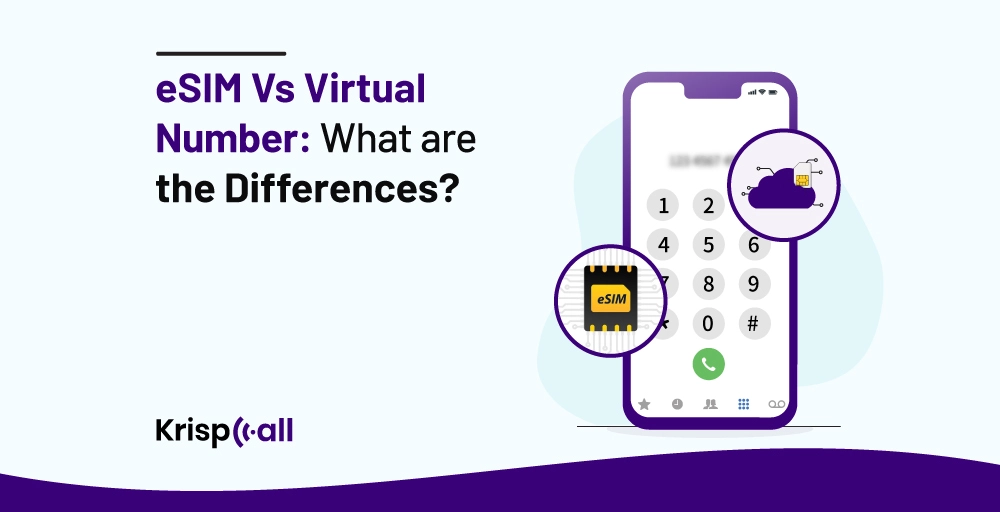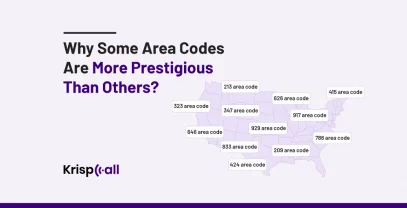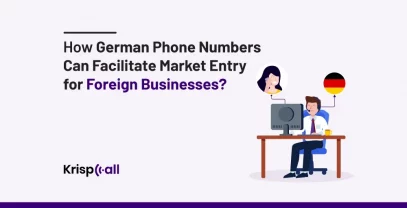In the ever-evolving world of telecommunications, two terms have emerged that may sound similar but have distinct functionalities – eSIM and virtual phone numbers.
While both offer enhanced connectivity and flexibility, understanding their differences is crucial for making informed decisions about your mobile communication needs.
That’s where technologies like eSIMs and virtual numbers become really handy. They offers fresh and innovative ways to stay connected in this digital world.
An eSIM, or embedded SIM, is a small chip embedded into our mobile device that functions just like a regular SIM card. On the other hand, virtual numbers are cloud-based phone numbers that operate via the Internet.
Both eSIMs and virtual phone numbers allow people to use phone numbers without needing physical SIM cards. However, they are not the same and have considerable differences.
In this blog post, we are going to dive into the fascinating world of eSIMs and virtual numbers, including the key differences between these technologies (eSIM vs. virtual Numbers), their unique uses, their advantages and disadvantages, and even walk you through the process of setting them up.
So, without further delay, let’s jump in.
What is eSIM?
eSIM, also known as embedded SIM, is a chip that’s physically attached to your mobile device’s motherboard and cannot be removed.
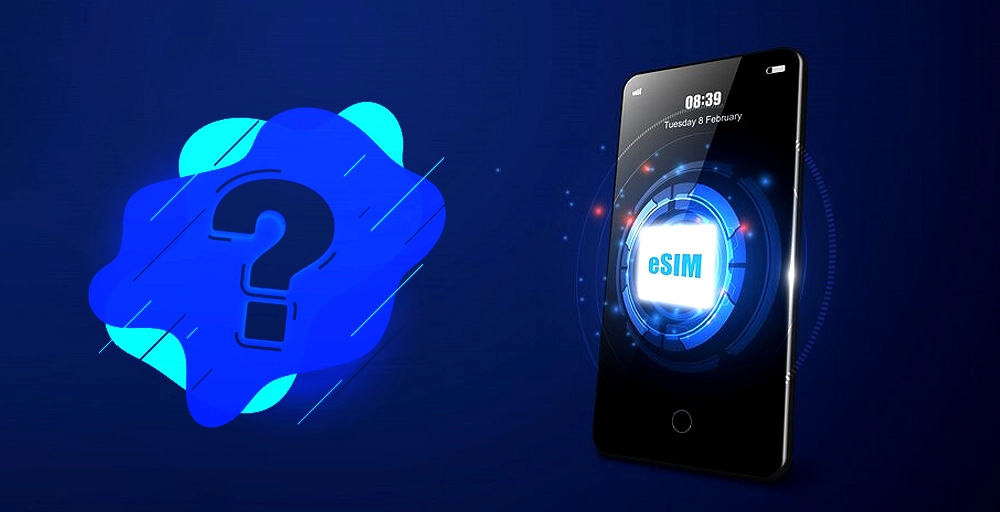
With an eSIM, you are able to connect to your carrier’s network, make calls, send messages, and access mobile data through your carrier, just like using a physical SIM card. The only difference is that a mobile data plan may be activated remotely without a physical SIM card.
Similarly, eSIM is a new concept, and as of 2024, it’s only available in some smartphones, including iPhones with the XS model and above (XS, 11, 12, SE 2020, etc.), Google Pixel devices with the Pixel 3 model and above, and new Samsung phones (S20, S21, Z Flip, Fold, Note).
Pros
- eSIMs eliminate the need for physical SIM cards.
- eSIMs are easy to activate; there is no need to visit a store and complete paperwork.
Cons
- It is available only on some premium devices.
- It is hard to switch devices with an eSIM.
What are the benefits of eSIM?
- Take up less space: eSIMs are embedded into the phone. So, they eliminate the need for a traditional SIM card slot in devices, taking less space.
- Efficient for frequent travelers: With an eSIM, users can switch between cellular networks without swapping physical SIM cards. Hence, travelers who often need to use different cellular networks in different countries find this very convenient.
- Flexibility: eSIMs offer users the advantage of effortlessly modifying their mobile subscriptions, incorporating new plans, or switching carriers remotely.
How much does eSIM cost?
Depending on your provider and plan, eSIM prices vary. Typically, eSIM costs between $20 and $100 per month.
What is a Virtual Number?
Virtual Number is a cloud-based phone number that operates through an internet connection. You can make and receive calls and send and receive text messages through a virtual number.

Not only this, you can access advanced VoIP features like call recording, call forwarding, call monitoring, voicemail, etc.
Pros
- It doesn’t require setting up hardware devices.
- It isn’t associated with physical location.
Cons
- Require a reliable internet connection.
- All virtual numbers don’t support the country’s emergency landline services like 911.
What are the benefits of a Virtual Phone Number?
- Establish a local presence: Businesses can create a local presence in different areas or countries through virtual phone numbers with specific area codes (local phone numbers). These numbers not only help build trust but also ensure that your business is easily accessible to its target audience.
- Cost-saving: Virtual phone numbers are more cost-effective than traditional phone lines, as there is no need to set up hardware devices to activate virtual numbers. Also, you can make international calls with zero roaming charges from a virtual number.
- Advanced features: A virtual phone number comes with several advanced features like call forwarding, voicemail-to-email transcription, call recording, auto-attendants, etc. By leveraging these VoIP features, businesses can enhance communication and streamline their operations while enjoying increased flexibility and scalability.
How much does a virtual phone number cost?
The cost of a virtual phone number starts from $10 to $50, depending on the provider and the subscription package you choose.
How virtual number is different from an eSIM-based phone number?
A virtual number is different from an eSIM-based phone number in several ways. Here is the comparison table between these two:
| Parameter | Virtual Number | e-SIM-based Phone Number |
| Physical SIM Card | There is no need for a physical SIM Card. | eSIM is embedded in the device. |
| Device support | Privacy and AnonymitySupports every device (smartphones, laptops, tablets, and computers) with an internet connection. | Supports only a few models of mobile phones like iPhones with the XS model and above, Google Pixel devices with the Pixel 3 model and above, and new Samsung phones (S20, S21, Z Flip, Fold, Note). |
| Portability | It is highly portable. It can be easily transferred between devices. | It is less portable than a virtual number and is tied to an eSIM-compatible device. |
| Location dependence | It is independent of location and can be used from anywhere. | It is dependent on the device’s physical location. |
| Privacy and Anonymity | One can maintain anonymity and privacy across social media platforms by using a virtual number. | You can’t maintain your privacy and anonymity with an eSIM number. |
| Activation Process | It is activated online or through an app. | A mobile carrier activates it. |
| Transferability | Easily transfer between different virtual number providers. | Locked to an eSIM provider and may not be transferable. |
What are the application areas of using eSIM and Virtual Number?
eSIM and virtual number are pretty versatile; they can be used in lots of different ways, and each use has its own cool benefits. Here are a few usual ways people use both of these technologies:
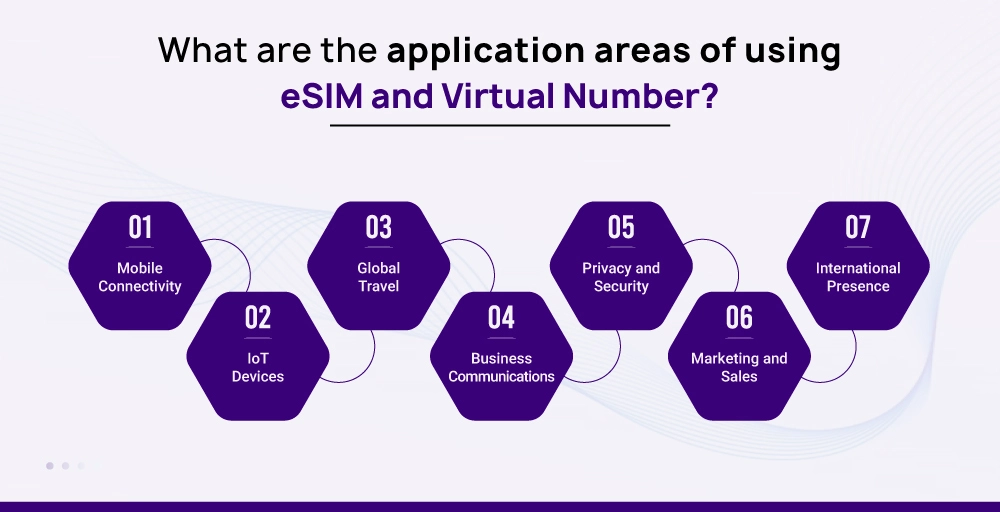
1. Mobile Connectivity:
Mobile connections nowadays widely rely on eSIMs. These are found in devices like smartphones, tablets, and smartwatches, and they give you cellular connectivity without needing a physical SIM card. What’s really convenient is that you even have the ability to change your carrier or your plan without having to swap out a physical SIM card.
2. IoT Devices
eSIMs can be incorporated into IoT devices like smart home gadgets or wearable tech. It allows these devices to connect with cellular networks without the necessity for a physical SIM card.
3. Global Travel
eSIMs can be a traveler’s best friend! With eSIMS, you can effortlessly switch between providers and phone numbers without the hassle of changing physical SIM cards. Just by scanning a QR code, you can even shift to a local carrier’s plan.
4. Business Communications
Companies can use virtual numbers to create a professional image in numerous areas without having to set up physical offices. This way, customers can get in touch through a local or toll-free virtual number.
5. Privacy and Security
To safeguard their personal phone numbers, people frequently opt for virtual numbers. Instead of giving out their main number, they share this virtual one, helping them keep their privacy intact. It comes in handy, notably when signing up for online dating apps, posting classified ads, or interacting with strangers.
6. Marketing and Sales
Businesses can track the success of marketing campaigns by using different virtual numbers for each campaign. It allows them to measure call volume and conversion rates more accurately.
7. International Presence
Companies that want to expand their international reach can use virtual numbers with local area codes to make it easier for customers in different countries to reach them without incurring high international calling charges.
Tips for choosing eSIM and Virtual Number
When you are choosing eSIMs and virtual numbers, here are a few things you want to think about to ensure you’re making the best choice possible:

1. Price
Make sure to compare the costs of different eSIM and virtual number providers. You should check out providers that clearly display their prices so you’re aware of all costs involved, like setup fees, monthly subscriptions, and usage fees.
2. Features
You must ensure that the eSIM and virtual number come with the features you need. For instance, your virtual number should have features such as call forwarding, voicemail, call recording, call analytics, integration options, etc.
On the other hand, your eSIM should be flexible when it comes to things like data plans, international roaming, support for multiple devices, data rollover, and compatibility with different networks.
3. Customer Support
Check the provider’s customer support availability, including their hours of operation, response times, and whether they offer 24/7 support. It is crucial if you encounter issues or have questions. Also, you should opt for providers that offer multiple ways to reach out to them – like email, phone call, chat, or through a resourceful knowledge base. That way, you can interact with them in the way that suits you best.
4. Coverage
You should also consider the network coverage your carrier provides for eSIMs and virtual numbers. Check that the network for your eSIM covers the places you’ll be using it the most.
Similarly, consider whether your virtual number provider can offer numbers with the area codes or international options you want.
eSIM Vs Virtual Number: Which is best for personal and business use?
For personal use, eSIM is the best option. With an eSIM, users can switch carriers and data plans with ease without the need for physical SIM cards. Additionally, eSIMs enable you to use the same number and data plan across multiple devices, providing a seamless user experience. This technology is ideal for frequent travelers.
Likewise, for business use, a virtual number is the best choice. It consists of several features that simplify business communication. These include call tracking, transcribing voicemails, analyzing call data, Automatic Voice Response (IVR), Automatic Call Distribution (ACD), recording calls, and so on.
What’s more, it enables businesses to create a local footprint in numerous geographic locales, even when they don’t physically operate there. Moreover, businesses can also leverage multiple virtual numbers for diverse marketing efforts, provide dedicated phone lines for customer support, and maintain a professional image.
FAQs
Which is better to choose, an eSIM or a Virtual Number?
The choice between eSIM and a virtual number depends on your specific needs and how you plan to use it. eSIM is better to choose if it’s important for you to have convenience, the flexibility of multiple devices, and travel frequently.
Meanwhile, the virtual number is better to choose if you run a company and want a separate line for professional purposes with advanced features. However, you can use both technologies simultaneously if they meet different needs in your personal or professional life.
Can I use eSIM or a Virtual number for making international calls?
Yes, you can use an eSIM or a virtual number for making international calls.
How much does it cost to buy an eSim or virtual number?
eSIM costs between $20 and $100 per month. Likewise, the cost of a virtual phone number starts from $10 to $50, depending on the provider and the subscription package you choose.
Are there any alternatives to eSim and virtual numbers?
No. There aren’t any alternatives to eSIM and virtual numbers.

